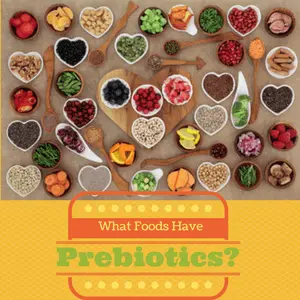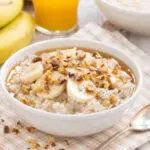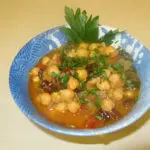
What Foods Have Prebiotics? How to Feed a Healthy Microbiome
Inside: What foods have prebiotics? And how do they fit as part of healthy eating habits?
Prebiotics seem to play a role in nourishing a healthy gut microbiota. It can seem daunting trying to wade through today’s information overload and feel confident in providing good answers when people ask for examples of prebiotic foods. Is there a simple prebiotic foods list?
Not all types of dietary fiber provide prebiotic benefits, as we discussed in part one of this series, which summarizes where today’s research stands on prebiotics’ potential health benefits. The good news is that we can translate this complex science into easy, doable choices.
Let’s focus now on the practical take-home steps following that update. What food choices are doable ways to nurture gut bacteria that promote good health?
What are Prebiotic Foods: Translating the Research
Prebiotics seem to protect health through direct effects on the gut microbes they support and through substances those gut microbes produce from the prebiotic. By definition, a prebiotic is a substance that supports specific gut microorganisms that provide a health benefit.
Here’s a brief summary of the very complex science, showing some of the challenges in translating laboratory studies to practical tips for healthy eating. The most well-supported choices come from controlled studies, which show prebiotic benefits from two particular carbohydrates: inulin-type fructans and the galacto-oligosaccharides (GOS), although many others are under investigation.
- Inulin-type fructans can be extracted from plants, produced by breaking down inulin in plants to form oligofructose, or produced from sucrose (forming “FOS”, fructo-oligosaccharides, sometimes used as an alternative sweetener in yogurt or other dairy products).
- Galacto-oligosaccharides (GOS) are found in pulses (dried beans, peas and lentils). However, prebiotic research often uses a specific type that’s commercially produced by treating lactose (the carbohydrate in milk) with a particular enzyme. It’s not clear whether its effects on gut bacteria are the same as GOS from whole foods.
Mounting research shows that diets high in plant foods and dietary fiber can change the bacteria that make up the gut microbiota. We also have studies linking such microbiota changes to lower levels of markers of inflammation and to other indicators of good health. The challenge now, while research is still limited: How can we put together the puzzle pieces….
Choose plant foods with carbohydrates & phytochemicals that support a healthy gut microbiota. Click To TweetWhat Foods Have Prebiotics?
Foods with Identified Prebiotics
Foods that provide inulin, inulin-type fructans, FOS and GOS, when a large enough part of the diet, tend to increase the variety of gut microbes (a beneficial effect).
- Jerusalem artichokes (also called “Sunchokes”) ~ try them roasted or mashed
- Globe artichokes (what most people think of when they hear “artichokes” ~ contain only about half the prebiotic compounds as Jerusalem artichokes, but still a delicious option with more prebiotics than most vegetables
- Onions ~ provide about 25% of the naturally occurring inulin and oligofructose in the American diet
- Pulses ~ dried beans (for example, kidney, navy and black beans), lentils, split peas and chickpeas (garbanzo beans)
- Garlic and Leeks ~use these to flavor almost any vegetable, pulse or other main dish or side
- Asparagus ~ delicious grilled, roasted, steamed, in stir-fries or salads, or with eggs ~ try frozen when fresh is not in season
- Bananas ~ look beyond breakfast, a portable pick-up snack with nuts, a thickener for smoothies
Foods with Potential to Feed a Healthy Microbiota
Certain types of dietary fiber can be fermented by gut bacteria to produce short-chain fatty acids (SCFA) that nurture the cells lining the colon, help strengthen the barrier that protects colon cells, and inhibit growth of harmful microbes. These fermentable fibers don’t meet the precise definition for prebiotics, but studies do suggest potential health benefits from these SCFAs .
Foods with Beta-Glucan (a viscous fiber that can also help lower elevated blood cholesterol and slow blood sugar rise after eating):
- Oats ~ hot or cold (have you tried “overnight oats”?), often overlooked as a snack
- Barley ~ hearty choice for soups and casseroles, terrific side dish in place of white rice
- Mushrooms ~ especially shiitake, chanterelle and oyster mushrooms, but also common white and brown button mushrooms. And mushroom stems contain even more beta-glucan than the caps.
- Seaweed ~ Do you get seaweed salad when you pick up sushi?
- Whole-grain wheat and rye also contain beta-glucan, although whole oats and barley provide more.
Foods with Sorbitol and Mannitol (natural carbohydrates classified as “polyols” that are another type of fermentable fiber):
- “Stone fruits” ~ Peaches, Nectarines, Plums, Apricots, Cherries ~ so nice in salads
- Apples and Pears ~ put slices in a sandwich anywhere in place of jelly
- Raisins ~ portable snack, delicious sweet flavor in chili
- Mushrooms (contain these polyols in addition to the beta-glucans noted above) ~ perfect addition to any stir-fry, roast like a dream, eggs’ perfect partner
Foods with Resistant Starch (a type of starch that is hard for our digestive enzymes to break down, which allows it to pass to the colon where gut bacteria ferment it to form SCFAs):
- Pulses – dried beans, peas and lentils – In addition to providing the known prebiotics listed above, much of the starch in pulses is resistant starch. So there is potential for double-benefit for health-promoting gut microbes.
- Whole grains, such as oatmeal, brown rice and whole wheat, reportedly have greater amounts of resistant starch than their refined versions.
- Potatoes, when cooked and cooled (as for potato salad), some of the easily digested starch becomes resistant starch.
- Bananas when less ripe still have some carbohydrate present as resistant starch
Research is still in early stages, and though promising, its benefit to the gut microbiota is not as easy to interpret as what’s seen with the inulin and fructan compounds, notes Patrice Cani, PhD. He’s a professor and researcher at the Université catholique de Louvain in Belgium investigating prebiotics, who graciously shared insights with me via email. There are five different types of resistant starch, and we need more study to clarify effects of amounts that are relevant to human diets.
Another reason to eat pulses at least 3 times a week: They’ve got prebiotics for a healthy gut! Click To TweetWhat Eating Habits Support a Healthy Microbiota?
Another expert on diet and the gut microbiota, Johanna Lampe, PhD, RD, of Fred Hutchinson Cancer Center, emphasizes, “There are a lot of other aspects of diet-microbe interactions besides fiber that are important.”
Don’t overdo the meat. Diets that are high in meat tend to promote higher levels of gut microbes that tolerate and feed off compounds generated with more meat intake, and these are not microbes that seem to support good health.
- In a study that exchanged customary diets for two weeks between two different populations, microbiota changed. Rural Africans switched to a high-fat, low-fiber “Western diet” experienced changes in gut microbiota that link to greater risk of colon cancer. Even in that short time, markers of inflammation increased, as did colon cell growth rates (associated with cancer risk). And these changes were related to the changes in microbiota. Part of that could stem from decreased fermentable fiber, but evidence suggests that diets high in meat add risk, too .
Focus on abundance and variety of plant foods. Polyphenols, a diverse group of natural compounds in plant foods, show potential to nurture a health-promoting gut microbiota. Reportedly 90 to 95 percent of polyphenols can’t be digested and absorbed in the small intestine, and pass through to the colon. Microbes in the colon break down these polyphenols into new compounds that demonstrate potential for important health protective effects.
- Walnuts provide one example: In one study, rats fed a diet with walnuts displayed greater diversity in the gut microbiota than those fed a diet that provided matching fat, fiber and protein, but no walnuts. This research is challenging, because looking at changes in gut microbes based on large categories can miss changes in more specific types within those broad groupings. But overall, increased variety and abundance of bacteria linked with health benefits suggests potential for a positive role.
- Other foods high in polyphenols that scientists are studying for possible protective interactions with the gut microbiota include berries, tea and coffee.
Many plant foods provide some level of polyphenol compounds, so this provides yet another reason that enjoying an abundance of whole plant foods is a smart move for health.
Do polyphenol-rich foods like walnuts & berries offer prebiotic benefits? Maybe! Click To TweetWhat about Prebiotics in Functional Foods and Supplements?
Although studies show that basic changes in eating patterns can change gut microbiota, it’s possible that some people (yet to be identified) may benefit from higher levels of prebiotics than they can get in a healthy diet. They might choose to use certain “functional foods” that contain added prebiotics. Other people may not need added prebiotic carbohydrates, but might be pleased to know when checking food labels that ingredients added to improve texture or flavor may actually be providing prebiotic benefit, too.
Chicory root fiber, sometimes labeled as Inulin or Oligofructose, is the source of those carbohydrates noted above identified as prebiotics. But often these are added to foods for other qualities. Inulin enhances moisture and adds a creamy texture, so you may see it in low-fat ice cream, or non-dairy or reduced-calorie yogurt. Baked goods and gluten-free breads use it to improve texture. Inulin and oligofructose add a sweet taste without the calories of sugar. So you may also see it in granola and other cereals or bars. And if you ever go to New Orleans, the city’s famous coffee is actually a blend of coffee and chicory root powder.
Hi-Maize, a resistant starch powder, is made from corn. You may see it in some commercial bread, cereal, pasta and snacks that show higher fiber content. Hi-Maize also comes as a separate ingredient to use in baking, add to smoothies or oatmeal, or thicken soup.
Some sweeteners, Polydextrose (manmade from natural carbohydrates, added as a sweetener or to improve the texture of foods) and Arabinogalactose (produced from other carbohydrates to serve as a stabilizer, binder or sweetener) are examples of prebiotic carbohydrates that can be found as additives in common foods.
Fiber supplements containing psyllium or inulin are prebiotics. However, some brands contain different kinds of fiber and provide other effects. Regardless, supplements offer the opportunity to boost fiber, but they don’t provide the other nutrients found in foods that supply dietary fiber, resistant starch or polyphenols.
Special Cases: Prebiotics & the Sensitive Gut
Although prebiotics offer exciting potential for health benefits, what about people with gut sensitivity, such as Irritable Bowel Syndrome (IBS)? As I noted in part 1 of this series on prebiotics, people with IBS may see themselves forced to decide between eating choices that improve their symptoms and choices that promote long-term health. Some types of fiber are fermented quickly and may lead to excess gas and bloating, even in people without IBS. Others are large molecules, fermented more slowly and less likely to bring these effects.
Must people with IBS choose eating for improved symptoms OR long-term health? Thx @KateScarlata_RD Click To TweetI turned to my colleague, Kate Scarlata, RDN, a digestive health expert dietitian and New York Times best-selling author for insights. Given the known health benefits of prebiotics for gut health, she incorporates them in smaller amounts in the diet of IBS patients, and increases gently to a patient’s tolerance. She notes, “In clinical practice, I have found that some IBS patients can tolerate resistant starch better than short chain prebiotic fibers such as fructans and GOS, so we start with small amounts of raw oats or unripe bananas initially.”
Fortunately, she reports that tolerance to FODMAP-containing foods can change over time. (FODMAP is an acronym for these carbohydrates: Fermentable Oligosaccharides, Disaccharides, Monosaccharides and Polyols.) “In clinical practice, we encourage IBS patients to continue to trial foods with prebiotics, as they may find tolerance improves over time.” Help from a registered dietitian nutritionist with gut health expertise can make a big difference for people dealing with sensitivity. And I’d recommend Kate’s newest book, The Low-FODMAP Diet Step by Step.
It’s a quick-start tool to help people discover the variety of fiber-rich foods they eat and find new options.
Yes, please!
Bottom Line on Foods with Prebiotics:
Technically, there’s a limited range of foods that have prebiotics, based on the technical definition. Not all fiber functions as a prebiotic, nurturing the gut microbiota that seems to play an important role in health. But including an abundance and variety of whole plant foods in overall healthy eating choices provides an array of carbohydrates and polyphenol compounds that seem to support a healthy microbiota. The research here is still emerging, so stay tuned for the big picture.
Want help exploring new, doable ways to include pulses at least three times a week? Sign up for the Half-Cup Habit 30-day challenge to target that goal. You’ll get free tips, menu ideas and recipes provided by U.S. and Canadian pulse growers.
(Once you master that, aim for pulses 5 to 7 days a week, as we discussed in a previous research brief here!)
Bindels LB, Walter J, Ramer-Tait AE. Resistant starches for the management of metabolic diseases. Current opinion in clinical nutrition and metabolic care. 2015;18(6):559-565.
Byerley LO, Samuelson D, Blanchard E, et al. Changes in the Gut Microbial Communities Following Addition of Walnuts to the Diet. J Nutr Biochem. 2017. DOI: https://doi.org/10.1016/j.jnutbio.2017.07.001.
Conlon MA, Bird AR. The impact of diet and lifestyle on gut microbiota and human health. Nutrients. 2014 Dec 24;7(1):17-44.
Dueñas M, Muñoz-González I, Cueva C, et al. A Survey of Modulation of Gut Microbiota by Dietary Polyphenols. BioMed Research International. 2015; 2015:850902.
Gibson GR, Hutkins R, Sanders ME et al. Expert consensus document: The International Scientific Association for Probiotics and Prebiotics (ISAPP) consensus statement on the definition and scope of prebiotics. Nat Rev Gastroenterol Hepatol. 2017 Aug;14(8):491-502.
Lockyer S and Nugent AP. Health effects of resistant starch. Nutrition Bulletin. March 2017; 42(1):10-41
Moshfegh AJ, Friday JE, Goldman JP, Chug Ahuja JK. Presence of Inulin and Oligofructose in the Diets of Americans. J. Nutr. 1999; 129(7):1407S.
O’Keefe SJ, Li JV, Lahti L, et al. Fat, fibre and cancer risk in African Americans and rural Africans. Nat Commun. 2015 Apr 28;6:6342.
O’Keefe SJ. Diet, microorganisms and their metabolites, and colon cancer. Nat Rev Gastroenterol Hepatol. 2016 Dec;13(12):691-706.
Ríos-Covián D, Ruas-Madiedo P, Margolles A, et al. Intestinal Short Chain Fatty Acids and their Link with Diet and Human Health. Front. Microbiol., 2016; 7:185.
Russell WR, Gratz SW, Duncan SH, et al. High-protein, reduced-carbohydrate weight-loss diets promote metabolite profiles likely to be detrimental to colonic health. Am J Clin Nutr. 2011 May;93(5):1062-72.
Sari M, Prange A, Lelley JI, Hambitzer R. Screening of beta-glucan contents in commercially cultivated and wild growing mushrooms. Food Chem. 2017 Feb 1;216:45-51.
Singh RK, Chang HW, Yan D et al. Influence of diet on the gut microbiome and implications for human health. J Transl Med. 2017 Apr 8;15(1):73.
Wilson B and Whelan K. Prebiotic inulin-type fructans and galacto-oligosaccharides: definition, specificity, function, and application in gastrointestinal disorders. J Gastroenterol Hepatol. 2017;32 Suppl 1:64-68.
My sincere thanks to Patrice D. Cani, PhD; Johanna Lampe, PhD, RD; and Kate Scarlata, RDN; for graciously lending their expertise to this post through comments shared in personal interviews.
Information on Kate Scarlata’s book is provided for information only. I receive no compensation for mentioning it or for any resulting purchases.
Top photo credit: 123rf.com – 58544580_s – profile_marilyna
5 Comments
Leave a Comment
Published : August 17, 2017
Tagged: cancer prevention, dietary fiber, fermentable fiber, fiber, healthy diet, healthy eating, inflammation, legumes, microbiome, microbiota, nuts, plant-based diet, polyphenols, prebiotic, prebiotic foods, prebiotics, pulses, reducing cancer risk, resistant starch, vegetables, whole grains
Meet the author/educator
I Take Nutrition Science From Daunting to Doable.™
As a registered dietitian nutritionist, one of the most frequent complaints I hear from people — including health professionals — is that they are overwhelmed by the volume of sometimes-conflicting nutrition information.
I believe that when you turn nutrition from daunting to doable, you can transform people's lives.
Accurately translating nutrition science takes training, time and practice. Dietitians have the essential training and knowledge, but there’s only so much time in a day. I delight in helping them conquer “nutrition overwhelm” so they can feel capable and confident as they help others thrive.
I'm a speaker, writer, and nutrition consultant ... and I welcome you to share or comment on posts as part of this community!






Great job Karen!
Thanks, Linda!
Do you have some favorite ways to include any of these foods with prebiotic potential in doable healthy eating?
I’d love to hear from those of you with tips to share!
All best,
Karen
[…] might vary among different people and may relate mainly to specific fibers that can be fermented by gut bacteria to form protective […]
I would like to know how prebiotics are good if we can’t digest them?
Thank you for reaching out, Tammy. I’m sorry if my explanation of prebiotics was not clear. — The benefits of prebiotics come from the way they support microbes in our gut that seem to promote good health. Although humans can’t digest prebiotics, these bacteria can break them down. The health-promoting gut microbes produce substances called short-chain fatty acids that protect our colon cells and reduce development of inflammation there and throughout the body.